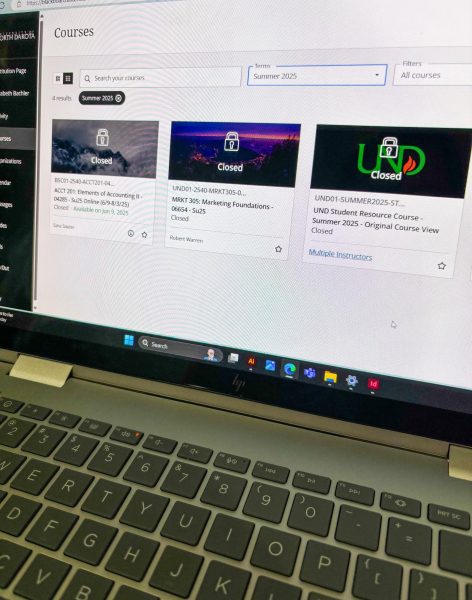New synthetic drug hits campus
Chemical called 25i, which has similar effects to LSD, found at UND.
University Police Department Chief Eric Plummer said UPD is working to keep synthetic drugs off campus. Photo by Ethan Arlien/The Dakota Student.
A new synthetic/designer drug, most commonly called 25i, has been reported in the area causing the University Police Department to warn students about its danger.
The drug, which also is called dime, 25C, NBOME or DOB, is a new and dangerous synthetic drug that can cause depression, aggression, hypertension, seizure activity, elevated white blood cell count, acute kidney damage, bleeding in the brain and heart failure.
“There has been a handful of reports,” UPD Chief Eric Plummer said.
Synthetic drugs are man made from chemicals and not naturally from a plant. This can make synthetic drugs, such as 25i, even more dangerous. The chemicals used in the drugs are hard to determine since different variations are constantly being tweaked by chemists.
Because of the unknown chemicals in the different variations of synthetic drugs, it is difficult for doctors to treat patients who have consumed them. Most of these drugs are so new that they will not be detected on a toxicology report.
“These drugs are more dangerous,” Plummer said. “We do not know what compounds are in it or who made it. We do not know the side effects, and it can affect other differently.”
Currently, 25i is illegal in North Dakota but lawmakers are constantly trying to keep up with the different variations to make sure all they are illegal.
Synthetic drugs became an issue in the Grand Forks community the summer of 2012 when two teenage boys died after consuming a form of synthetic drug. The problem, however, does not appear to be widespread, according to UND Health and Wellness Director Jane Croeker.
“Most students are smart enough not to use it,” Croeker said.
Some students are engaging in other types of drugs.
According to the Student Health and Wellness Highlights 2012, 11 percent of students have used marijuana in the last 30 days and 26 percent of students have used it in the past year. Marijuana is the most prevalent drug in the area, with many arrests on and off campus, according to Plummer. However, UND students appear to use marijuana less than students across the nation according the 2010 National Reference Group. UND also has a small amount of students who abuse prescription drugs.
“We feel that it is our duty to inform the the community about this and that they may come across it,” Plummer said. “We work with the local drug task force to provide ways to keep drugs out of the campus community.”
Ashley Marquis is a staff writer at The Dakota Student. She can be reached at ashley.m.marquis@my.und.edu.






